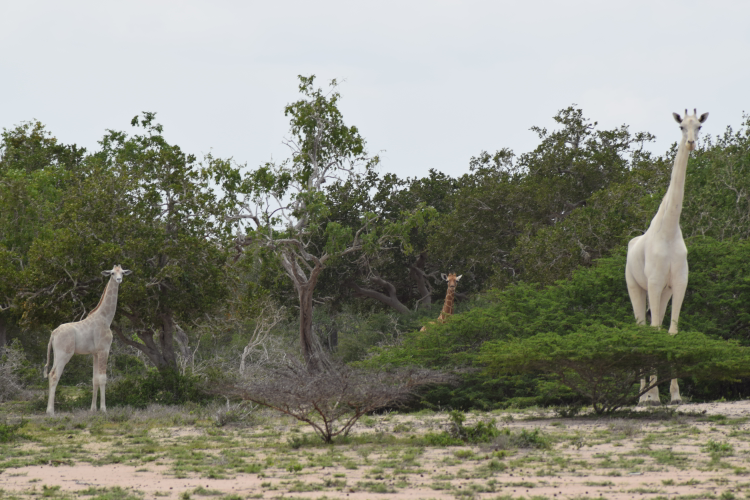Ultra-rare white giraffes spotted in Kenya
The mother and calf are only the third recorded example of leucistic giraffes in history

A pair of giraffes with a rare genetic mutation that turns their skin white has been captured on camera for only the third time in history.
The mother and calf were first spotted by locals in the Ishaqbini conservation area, northern Kenya, in June. Last month, rangers from the Hirola Conservation Program, which manages the protected area, came face-to-face with the creatures and captured their close encounter on video.

“They were so close and extremely calm and seemed not disturbed by our presence,” the HCP wrote in a blog. “The mother kept pacing back and forth a few yards in front of us while signalling the baby giraffe to hide behind the bushes.”
The Week
Escape your echo chamber. Get the facts behind the news, plus analysis from multiple perspectives.

Sign up for The Week's Free Newsletters
From our morning news briefing to a weekly Good News Newsletter, get the best of The Week delivered directly to your inbox.
From our morning news briefing to a weekly Good News Newsletter, get the best of The Week delivered directly to your inbox.

Their unusual appearance is due to a condition called leucism, rather than the better-known albinism. While albinism means a total loss of one form of pigmentation, leucism is a partial loss of all pigmentation.
This is only the third known instance of the rare genetic mutation in the species.
The first documented sighting occurred in January 2016, in a national park in Tanzania. Locals named the white calf Omo after a popular local brand of detergent, National Geographic reports.
Two months later, a second white giraffe was seen in the same Kenyan conservation park.
A free daily email with the biggest news stories of the day – and the best features from TheWeek.com
The mother and calf are an extremely rare example of an increasingly rare breed. The reticulated giraffe, also called the Somali giraffe, is considered a “vulnerable” subspecies.
“As recently as the turn of the millennium, some 36,000 remained,” according to the Reticulated Giraffe Project. That number is now thought to be around 8,500.
A ranger identified as Bashir told the HCP that the white giraffes appeared to be a new phenomenon.
“I remember when I was a kid, we never saw them. It must be very recent and we are not sure what is causing it,” he said.
-
 How Bulgaria’s government fell amid mass protests
How Bulgaria’s government fell amid mass protestsThe Explainer The country’s prime minister resigned as part of the fallout
-
 Femicide: Italy’s newest crime
Femicide: Italy’s newest crimeThe Explainer Landmark law to criminalise murder of a woman as an ‘act of hatred’ or ‘subjugation’ but critics say Italy is still deeply patriarchal
-
 Brazil’s Bolsonaro behind bars after appeals run out
Brazil’s Bolsonaro behind bars after appeals run outSpeed Read He will serve 27 years in prison
-
 Americans traveling abroad face renewed criticism in the Trump era
Americans traveling abroad face renewed criticism in the Trump eraThe Explainer Some of Trump’s behavior has Americans being questioned
-
 Nigeria confused by Trump invasion threat
Nigeria confused by Trump invasion threatSpeed Read Trump has claimed the country is persecuting Christians
-
 Sanae Takaichi: Japan’s Iron Lady set to be the country’s first woman prime minister
Sanae Takaichi: Japan’s Iron Lady set to be the country’s first woman prime ministerIn the Spotlight Takaichi is a member of Japan’s conservative, nationalist Liberal Democratic Party
-
 Russia is ‘helping China’ prepare for an invasion of Taiwan
Russia is ‘helping China’ prepare for an invasion of TaiwanIn the Spotlight Russia is reportedly allowing China access to military training
-
 Interpol arrests hundreds in Africa-wide sextortion crackdown
Interpol arrests hundreds in Africa-wide sextortion crackdownIN THE SPOTLIGHT A series of stings disrupts major cybercrime operations as law enforcement estimates millions in losses from schemes designed to prey on lonely users


